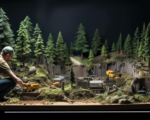In classrooms around the world, a quiet revolution is taking place as educators, students, and communities embrace the transformative power of STEM education. At the heart of this movement are passionate individuals dedicated to sparking curiosity and cultivating a love for science, technology, engineering, and mathematics.
Meet Sarah Williams, a high school physics teacher whose enthusiasm for STEM is infectious. With a knack for turning complex theories into engaging experiments, she’s breaking down barriers and inspiring her students to see the world through the lens of scientific inquiry.
“For me, STEM is not just about equations on a board. It’s about fostering a sense of wonder and encouraging my students to ask questions,” says Williams. Her classroom is a dynamic space where students build rockets, program robots, and explore the mysteries of the universe. “It’s incredible to see their eyes light up when they realize the practical applications of what they’re learning.”
Beyond the traditional classroom setting, initiatives like STEM clubs and after-school programs are creating opportunities for students to delve deeper into their interests. Michael Rodriguez, a high school senior and coding enthusiast, shares his experience in a STEM club where students collaborate on coding projects. “It’s not just about learning to code; it’s about teamwork, problem-solving, and the satisfaction of creating something meaningful.”
In underprivileged communities, educators are championing STEM as a tool for empowerment. Maria Gomez, a middle school teacher in a resource-constrained neighborhood, has witnessed firsthand the impact of STEM programs on her students. “STEM opens doors. It’s about showing these kids that their dreams are valid, and they have the potential to achieve anything they set their minds to.”
STEM education is not just about equations and experiments; it’s about nurturing a mindset of resilience and curiosity. Collaborative efforts between schools and local industries further bridge the gap between the classroom and the real world. Engineers, scientists, and tech professionals visit schools, sharing their experiences and providing valuable insights.
The human touch extends to parents as well. Families are getting involved in STEM education through community science fairs, robotics competitions, and coding workshops. Emily Johnson, a mother of two, expresses the joy of participating in a family coding event. “It’s not just about my kids learning; it’s about us discovering together. It’s quality time invested in their education.”
STEM education is not merely an academic endeavor; it’s a celebration of human potential and the belief that every child, regardless of background, deserves the chance to explore, question, and innovate. As educators, students, and communities come together to embrace the human side of STEM education, they are not just preparing for the future; they are actively shaping it with creativity, passion, and the enduring spirit of discovery.









